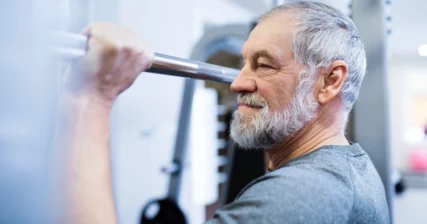Listen on: Apple Podcasts | Spotify
Bigger is better. At least it is when it comes to your muscles.
I’m not referring to how muscle looks. That would be an opinion. I’m referring to how it functions to create a strong, healthy, vigorous body. Unfortunately, the way most fitness influencers and personal trainers promote themselves, you’d think building muscles is only about aesthetics. I don’t want you to fall into that trap, because your level of muscle mass determines so much more than how you might look.
Building muscle for as long as you can, and doing what’s necessary to maintain it in the years that follow, can have a significant effect on your quality and quantity of life. In the average person, physical performance peaks in their 20s to 30s, after which they slowly lose muscle, strength, and physical performance.1Keller K, Engelhardt M. Strength and muscle mass loss with aging process. Age and strength loss. Muscles Ligaments Tendons J. 2014 Feb 24;3(4):346-50. PMID: 24596700; PMCID: PMC3940510. After age 50, muscle mass and strength decline more rapidly, with strength decreasing as much as 15% per decade. Your level of muscle mass will be a bigger factor in longevity than your level of body fat. Without enough muscle, you’ll likely succumb to disease faster and die younger.
Your Quality-of-Life Savings Account
Have you ever had a family member experience a significant illness like heart disease, cancer, or even a severe case of COVID or the flu? Chances are, their disease or illness caused rapid muscle loss. What about an injury where a limb was immobilized, or they were forced into bed rest for a while? What happened? They lost muscle and maybe gained fat. Has something like that happened to you? If not, it will. It’s part of living.
At 46 years old, I’ve experienced and come back from:
- Acute Lymphocytic Leukemia (Cancer)
- Appendicitis and an appendectomy
- Left Achilles’ tendon rupture and surgical reattachment
- Left biceps tendon rupture and surgical reattachment (6 years later)
- Fractured C6 & C7 vertebrae with a severe spinal cord injury which led to emergency anterior cervical discectomy and fusion
Illness and injuries are inevitable. You can live in fear, hiding in your home, wearing masks wherever you go, or avoiding any activity that might cause you to slip, fall, or crash. You might reduce your risk of physical illness or injury, but you’ll end up mentally ill. Or, you can accept that life poses risk, and be as well prepared as possible to bounce back from injury or illness when it happens to you.
Preparation requires a bank of amino acids to draw from because recovery from injury and illness burns through amino acids as a California wildfire burns through trees. You can, and should, eat a high-protein diet, which provides dietary sources of amino acids, but you often end up drawing from the amino acids stored in muscle protein. The more muscle you have when you get sick or hurt, the more you can afford to lose without compromising your long-term health. In this way, your muscle tissue acts like an emergency savings account.
In addition, you’ll eventually reach an age where sarcopenia, or age-related muscle loss, becomes a reality. At that time, you’ll be able to slow the process with good lifestyle and nutrition choices, but you’ll still lose muscle at an accelerated rate. The more you have when that process begins, the longer you’ll be able to continue doing the things you love to do before becoming too weak and fragile to do them. In this way, muscle mass acts like a retirement account.
The stressed state, such as that associated with sepsis, advanced cancer, and traumatic injury, imposes greater demands for amino acids from muscle protein breakdown than does fasting.
The underappreciated role of muscle in health and disease2Wolfe RR. The underappreciated role of muscle in health and disease. Am J Clin Nutr. 2006 Sep;84(3):475-82. doi: 10.1093/ajcn/84.3.475. PMID: 16960159.
Read also: Why You Should Workout While Injured.
Blood Sugar Management
According to the CDC, one in ten Americans has type 2 diabetes. One in three has pre-diabetes. The difference between the two groups is that those with type II diabetes have gotten bad enough that their blood sugar reached the cutoff where a doctor can diagnose the disease and start handing out prescriptions. Those with pre-diabetes are well on their way but haven’t yet reached the cutoff.
Reducing carbohydrates can help get blood sugar under control, but the more muscle you have, the more storage space you have for carbohydrates. Bigger, healthy muscles help to keep blood sugar in check, reversing type 2 diabetes or pre-diabetes.
alterations in the metabolic function of muscle are central to the development of insulin resistance and ultimately diabetes
The underappreciated role of muscle in health and disease
Protects your joints
How many middle-aged and older adults do you know who talk about aches and pains in their joints? I would imagine you know many. Building and maintaining muscle won’t completely eliminate joint degeneration, but it can help slow the debilitating effects. Stronger, bigger muscles provide more support around each of your joints, and help to maintain proper alignment throughout your body, which also reduces joint stress.
If I had a dollar for every person who told me they couldn’t squat because they had a bad back or bad knees…it would be a lot of money. Anyway, the reality is, for most of those people, if they’d go through the small amount of discomfort necessary to start building muscle, they’d find out that their bad knees and bad back wouldn’t be bad anymore.
I often use and recommend joint-supporting supplements like AgilEase from Young Living, but I use and recommend them in addition to muscle-building strength training, not in place of it.
Here’s one more case for building joint-supporting muscle: Falls are the second-leading cause of death worldwide, next to auto accidents. When you fall, the strength of the muscles surrounding your joints can determine whether your fall leads to a serious injury or not. If you’re strong enough, your muscles brace your joints and minimize the pain and injury. If you’re weak and fall, you’re more likely to break.
Reduces inflammation
Systemic inflammation causes numerous health problems, including cardiovascular disease, cognitive decline, and joint degeneration. Low muscle mass is correlated with higher inflammation levels. In this way, muscle mass acts like an organ, regulating inflammation and acting as part of your immune system.
Skeletal muscle can actively alter the pro- and anti-inflammatory immune system, regulating innate and adaptive immune responses. Chronic low-grade systemic inflammation may occur as a direct result of low muscle mass.
Markers of inflammation and their association with muscle strength and mass: A systematic review and meta-analysis3Tuttle CSL, Thang LAN, Maier AB. Markers of inflammation and their association with muscle strength and mass: A systematic review and meta-analysis. Ageing Res Rev. 2020 Dec;64:101185. doi: 10.1016/j.arr.2020.101185. Epub 2020 Sep 26. PMID: 32992047.
Triggers release of hormones
Hormones like testosterone, IGF-1, and growth hormone help build muscle but interestingly, muscle contraction causes growth hormone secretion too. So, contracting muscles, as you would during an intense training session, secretes one of the major hormones necessary to build more muscle.
Muscular force production also stimulates the release of various types of GH from the pituitary gland (a small gland in the brain).
Hormonal Response to Muscle Contraction4Hormonal Response to Muscle Contraction. 17 Sept. 2021, https://www.nsca.com/education/articles/kinetic-select/hormonal-response-to-muscle-contraction/.
Raises metabolic rate
Muscle costs your body a lot of energy. That’s why it gets rid of muscle you don’t use. But as long as you use it consistently, your body will maintain the muscle in spite of the significant amount of energy it requires. In doing so, it’ll look for energy elsewhere, such as your body fat.
By investing a small amount of time each week, following a well-designed strength and conditioning program, eating a high-protein diet, and getting enough sleep, you tell your body it needs more muscle. As long as you keep giving it the signal, it’ll respond by increasing the size of your muscle cells, thereby increasing your metabolic rate.
If you burn more energy at rest, it’ll be a lot easier to keep your body fat levels in check.
Makes you look healthier
Muscle makes you look healthier because carrying more muscle mass makes you healthier. I’m often surprised by the number of healthcare practitioners, and even some fitness professionals, who don’t look strong and healthy. Many are overweight or obese and are supposed to influence others toward better health.
On the flip side, I’ve noticed more and more fitness professionals marketing themselves with half-naked photos and videos. I get that it might attract some vanity-driven clients, but in my opinion, it misses the mark for which our professions aim. I’ve also started to think that there’s an indirect correlation between how much skin a fitness influencer shows in their Instagram photos and their actual knowledge about health and fitness, but I digress.
When you’re stronger and more muscular, you carry yourself differently. You maintain a better posture. And as you carry yourself differently, you start to feel differently. If you look sloppy, you’ll feel sloppy, and others will be more likely to see you as sloppy. If you look strong, you’ll feel strong, and others will be more likely to see you as a strong person.
Protects your heart
You might believe cardiovascular exercise or endurance training is the only way to exercise your heart. Muscle-building resistance training also exercises your heart. In fact, excessive aerobic exercise can be detrimental to your heart’s health. It can also cause significant muscle loss, lower testosterone, and compromise joint health.
Muscle mass is cardioprotective. A 10-year study followed men and women without any sign of cardiovascular disease at the beginning. Not surprisingly, men in general were more likely to develop cardiovascular disease. What stood out, though, was that those with the highest levels of muscle mass were the least likely to develop cardiovascular disease. They were 81% less likely to have a heart attack or stroke.
Summary
If you consider all of the diseases we face in the modern world, you’ll see that muscle mass and its effect on your metabolism and other systems in your body plays a significant role in the disease’s progression. Cancer, heart disease, diabetes, osteoporosis, strokes, cognitive decline…all of these diseases and more can be at least slowed by a concerted effort to build or maintain muscle mass.
On top of that, mental health is becoming more of an issue, and evidence suggests that people with more muscle mass are less likely to deal with mental health issues.
Muscular strength is inversely and significantly related to depression symptoms among adults and older adults. This may be partially explained by physical activity, but also by the associations between muscular fitness and functional limitations and disabilities, as well as frailty and health-related quality of life, which in turn are related to depression symptoms. Interventions aiming to improve muscular fitness have the potential to promote mental health and prevent depression.
The Effect of Muscular Strength on Depression Symptoms in Adults: A Systematic Review and Meta-Analysis5Marques A, Gomez-Baya D, Peralta M, Frasquilho D, Santos T, Martins J, Ferrari G, Gaspar de Matos M. The Effect of Muscular Strength on Depression Symptoms in Adults: A Systematic Review and Meta-Analysis. Int J Environ Res Public Health. 2020 Aug 6;17(16):5674. doi: 10.3390/ijerph17165674. PMID: 32781526; PMCID: PMC7460504.
So, is bigger better? In the case of muscle mass, the evidence says, “Yes!” At least, bigger muscles are better when they’re built naturally (not with steroids).



